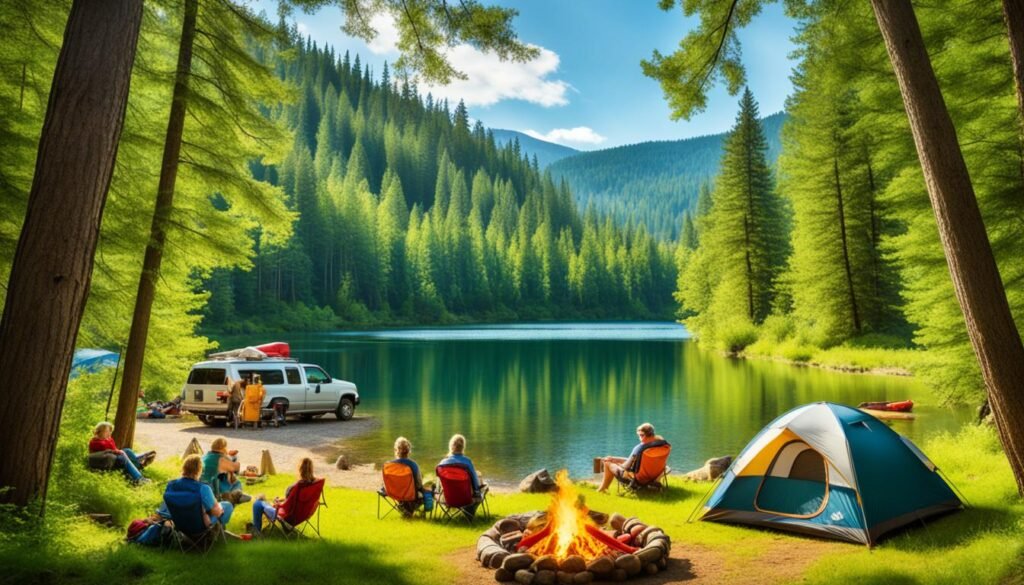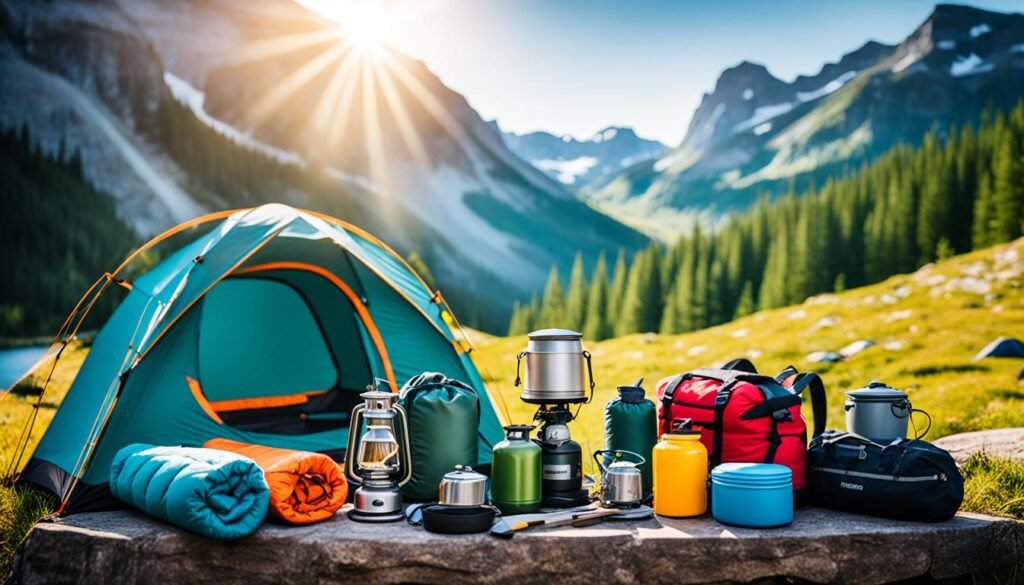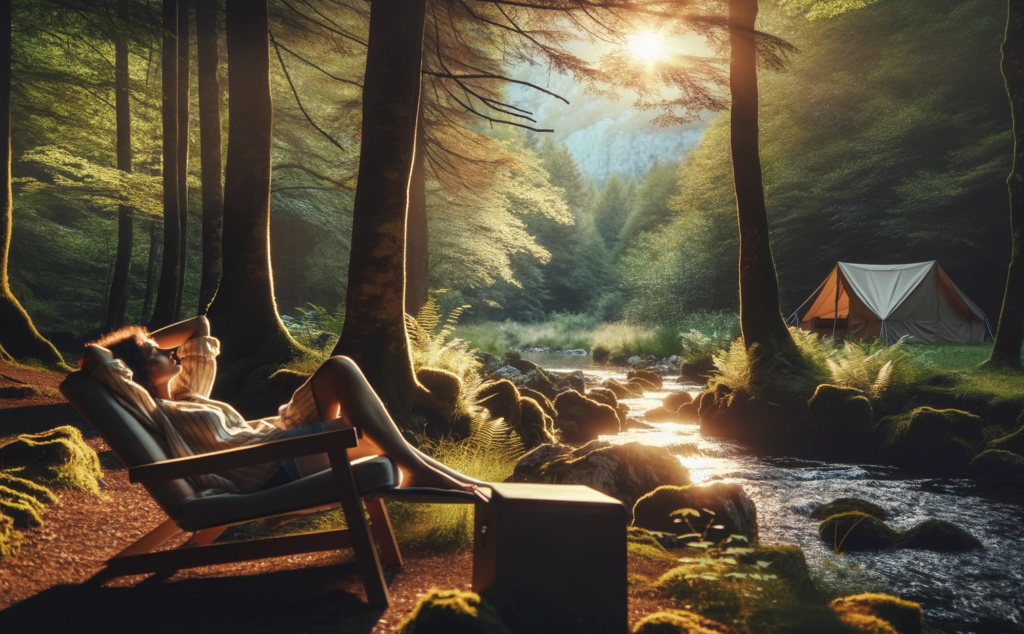Camping is a form of outdoor recreation or outdoor education that involves overnight stays in a temporary shelter, such as a tent. It provides an opportunity to connect with nature, escape the demands of daily life, and experience the beauty of the great outdoors. But have you ever wondered why camping was invented in the first place?
Before we delve into the origins of camping, let’s explore what makes it unique. The act of staying and sleeping in an outside area for one or more days and nights distinguishes camping from other outdoor activities. It allows individuals to immerse themselves in nature, participate in outdoor adventures, and enjoy the tranquility of temporary shelter.
Camping dates back to the early 20th century when it gained popularity among elites seeking to reconnect with nature and escape the hustle and bustle of city life. Over time, camping grew in popularity among other socioeconomic classes, becoming a cherished pastime for individuals and families alike.
But what led to the invention of camping? It was the vision and enthusiasm of individuals like Thomas Hiram Holding that brought camping into the mainstream. Holding, a British traveling tailor, was inspired by his experiences traveling across the American prairies and embarking on a cycling and camping tour in Ireland. His book, “The Campers Handbook,” published in 1908, introduced camping to a wider audience and sparked the formation of the first camping group, the Association of Cycle Campers.
Since those early beginnings, camping has continued to grow in popularity. It is now a key part of many youth organizations, such as scouting, where it plays an essential role in personal growth and development. School camping trips also offer numerous benefits, providing students with the opportunity to learn valuable skills, foster teamwork, and appreciate the natural world.
Today, camping has become an established family holiday standard, with campsites widespread across Europe and North America. Modern campers often visit national and state parks, wilderness areas, and commercial campgrounds, immersing themselves in the beauty of nature.
Key Takeaways:
- Camping is a form of outdoor recreation that involves overnight stays in a temporary shelter.
- The origins of camping can be traced back to individuals like Thomas Hiram Holding, who popularized the activity in the early 20th century.
- Camping is a key part of many youth organizations and can play an essential role in personal growth and development.
- Camping has become a popular family holiday choice, with campsites available in various locations around the world.
- Modern campers frequently visit national and state parks, wilderness areas, and commercial campgrounds to enjoy the beauty of nature.
The Origins of Camping
The history of recreational camping can be traced back to Thomas Hiram Holding, a British traveling tailor. He popularized a different type of camping in the early twentieth century, inspired by his experiences traveling across the American prairies and embarking on a cycling and camping tour in Ireland.
Holding’s passion for the outdoors led him to write a book called “The Campers Handbook” in 1908. This influential publication introduced camping to a wider audience and provided essential guidance on equipment, techniques, and etiquette. It became a seminal guide for aspiring campers, encouraging them to embrace the adventure and freedom of outdoor living.
The popularity of Holding’s book and the growing interest in recreational camping led to the formation of the first camping group, the Association of Cycle Campers. This organization aimed to promote camping as a recreational activity and organize camping trips for its members.
| Year | Event |
|---|---|
| 1908 | Publication of “The Campers Handbook” |
| 1909 | Formation of the Association of Cycle Campers |
Thomas Hiram Holding’s dedication and enthusiasm for the great outdoors helped establish camping as a popular recreational activity. His contributions paved the way for the camping lifestyle we know and love today.
The Growth of Camping
Over the years, camping has experienced a surge in popularity, becoming a beloved outdoor activity for many enthusiasts. Modern campers are drawn to the allure of national and state parks, wilderness areas, and commercial campgrounds that offer breathtaking natural landscapes and immersive camping experiences.
Camping has also found a significant place within various youth organizations, playing a pivotal role in teaching self-reliance and teamwork. Scouting programs, for instance, often incorporate camping as a means to foster personal growth and character development in young individuals.
Moreover, school camping trips have gained recognition for the multitude of benefits they offer to students. These trips allow students to step out of their comfort zones, connect with nature, and develop essential life skills, all while creating lasting memories.

Furthermore, camping has become a staple choice for family holidays, offering a unique opportunity for quality bonding time. Campsites are now widespread across Europe and North America, catering to the needs of families seeking outdoor adventures and unforgettable experiences.
Types of Camping
When it comes to camping, various types cater to different preferences and activities. Whether you prefer a leisurely trip or an adventurous expedition, there’s a camping style for everyone. Let’s explore some common types of camping:
Canoe Camping
Canoe camping combines the thrill of paddling with the tranquility of camping. It involves traveling by canoe and setting up camp along the way. This type of camping allows you to explore scenic waterways, enjoy fishing opportunities, and immerse yourself in nature’s serenity.
Car Camping
Car camping offers convenience and comfort for those who like to bring along more gear and supplies. With your vehicle serving as the base camp, you can easily transport all the necessary equipment and enjoy a cozy camping experience. Car camping is ideal for families or those who prefer a more relaxed camping style.
Glamping
For those who enjoy the outdoors but also crave luxury, glamping is the perfect choice. Glamping, or glamorous camping, provides all the comforts of home while being immersed in nature. From deluxe tents to luxurious amenities, glamping offers a unique and stylish camping experience.
Backpacking
Backpacking is the epitome of adventure and self-sufficiency. It involves carrying all necessary gear on your back and trekking into remote areas. Backpacking allows you to explore untouched wilderness, challenge yourself physically, and experience a deep connection with nature.
Camping Types Comparison
| Camping Type | Description | Key Features |
|---|---|---|
| Canoe Camping | Traveling by canoe and camping along the way. | – Exploration of waterways – Fishing opportunities – Immersion in nature |
| Car Camping | Camping with a vehicle as the base camp. | – Convenience and comfort – More gear and supplies – Ideal for families |
| Glamping | Glamorous camping with luxurious amenities. | – Comfort and style – Deluxe tents – Upscale facilities |
| Backpacking | Carrying gear and camping in remote areas. | – Adventure and self-sufficiency – Exploration of untouched wilderness – Physical challenge |
Each type of camping offers a unique experience and appeals to different preferences. Whether you seek tranquility on the water, prefer the comforts of a vehicle, desire a luxurious camping experience, or crave an adventurous journey, there’s a camping style that will suit your taste. Enjoy the great outdoors and create memorable moments with the camping style that resonates with you.
Camping Gear and Equipment
Camping equipment has evolved over the years to provide comfort and convenience to campers. When embarking on a camping trip, it is essential to have the right gear to ensure a successful and enjoyable outdoor experience. The following are some of the must-have camping equipment:
Tent
A tent is the primary camping shelter that provides protection from the elements, insects, and wildlife. Tents come in various sizes and designs to accommodate different group sizes and weather conditions. From compact solo tents to spacious family tents, there is a tent for every camping need.
Lantern
A lantern or flashlight is essential for illuminating the camping area at night. It helps create a safe and comfortable environment, allowing campers to navigate and perform tasks in the dark. Lanterns come in different types, including battery-powered, solar-powered, and rechargeable options.
Stove
A camp stove is an important piece of camping equipment for preparing meals. Whether you prefer cooking over an open fire or using a portable stove, having a reliable heat source is crucial. Camp stoves are available in various fuel types, including propane, butane, and multi-fuel options.
Sleeping Bag
A comfortable sleeping bag is essential for a good night’s sleep while camping. Sleeping bags provide insulation and warmth, keeping campers cozy during colder nights. They come in different temperature ratings and styles to suit varying climates and personal preferences.
The development of lightweight and portable camping gear has revolutionized the camping experience. Advancements in materials and technology have made camping gear more compact, durable, and easy to transport. From the early designs of tents modeled after Native American teepees to the introduction of portable cook stoves, camping gear has continuously improved to enhance the camping experience.
| Equipment | Description |
|---|---|
| Tent | A portable shelter that protects from the elements and wildlife. |
| Lantern | An illuminating device that helps light up the camping area at night. |
| Stove | A heat source for cooking meals while camping. |
| Sleeping Bag | A portable sleeping arrangement that provides insulation and comfort. |
These essential camping gear items play a critical role in ensuring a comfortable and enjoyable camping experience. By investing in quality gear and staying updated with the latest innovations, campers can make the most of their outdoor adventures.

Camping Treats and Traditions
Camping is often associated with delicious treats and traditions. One of the most iconic camping treats is the s’more, a combination of marshmallows, chocolate, and graham crackers toasted over a campfire. The tradition of making s’mores around a campfire has been enjoyed by campers for decades. Other camping traditions include storytelling, campfire songs, and outdoor cooking. These traditions add to the overall experience of camping and create lasting memories for campers of all ages.
Camping Treats Comparison
| Treat | Description |
|---|---|
| S’mores | A classic camping treat made with toasted marshmallows, chocolate, and graham crackers. |
| Hot Dogs | A staple of camping meals, hot dogs can be grilled over the campfire and enjoyed in a bun with various toppings. |
| Campfire Popcorn | Popped over an open flame, campfire popcorn is a tasty and easy snack to enjoy while sitting around the fire. |
| Foil Packet Meals | A versatile camping meal option, foil packet meals are made by wrapping ingredients in aluminum foil and cooking them over the fire or on a grill. |
| Dutch Oven Recipes | Using a Dutch oven, campers can cook a variety of delicious meals like stews, casseroles, and even desserts. |
Conclusion
Camping has evolved over the years to become a beloved outdoor activity enjoyed by millions of people around the world. Its rich history can be attributed to the efforts of individuals like Thomas Hiram Holding and William H.H. Murray, who popularized recreational camping and sparked a movement.
Today, camping offers a wide range of experiences, accommodating different preferences and interests. Whether you prefer the convenience of car camping, the adventure of backpacking, or the luxury of glamping, there’s a camping style for everyone.
As our modern lives become increasingly hectic and technology-driven, camping provides a much-needed opportunity to disconnect and reconnect with nature. The future of camping looks promising, with new innovations in camping gear making outdoor adventures more accessible and enjoyable than ever before. Additionally, the continued growth of outdoor recreation and the desire for authentic experiences suggest that camping will remain a popular choice for individuals and families seeking to create lasting memories amidst the beauty of the natural world.
How Did Tarp Camping Come About as a Method of Camping?
Tarp camping, a method of camping using a tarp for shelter, has gained popularity due to its versatility and affordability. Tarp camping benefits and tips include lightweight gear, flexibility in setup, and reduced cost. This method originated as a practical solution for minimalist campers seeking a simple, no-frills experience in the great outdoors.
FAQ
Why was camping invented?
Camping was invented as a form of outdoor recreation and education that involves overnight stays in a temporary shelter, such as a tent. It became popular among elites in the early 20th century and has since grown in popularity among other socioeconomic classes.
Who popularized recreational camping?
Thomas Hiram Holding, a British traveling tailor, is credited with popularizing recreational camping in the early 20th century. Inspired by his experiences traveling across the American prairies and cycling and camping tour in Ireland, Holding published “The Campers Handbook” in 1908, introducing camping to a wider audience and leading to the formation of the first camping group, the Association of Cycle Campers.
Where do campers frequently visit?
Modern campers frequently visit publicly owned natural resources such as national and state parks, wilderness areas, and commercial campgrounds.
What are the different types of camping?
There are various types of camping, including canoe camping, car camping, glamping, and backpacking. Canoe camping involves traveling by canoe and camping along the way. Car camping refers to camping with a vehicle, which allows for more comfort and convenience. Glamping, or glamorous camping, combines camping with luxury amenities. Backpacking involves carrying all necessary gear on one’s back and camping in remote areas.
What equipment is needed for camping?
Essential camping gear includes a tent for shelter, a lantern or flashlight for illumination, a camp stove for cooking, and a sleeping bag for a comfortable sleep. Over the years, camping gear has evolved to provide comfort and convenience to campers, with lightweight and portable options now available.
What are some camping treats and traditions?
One of the most iconic camping treats is the s’more, a combination of marshmallows, chocolate, and graham crackers toasted over a campfire. Other camping traditions include storytelling, campfire songs, and outdoor cooking.
What does the future of camping look like?
Camping continues to be a popular outdoor activity enjoyed by millions of people worldwide. As more people seek to disconnect from the modern world and enjoy nature, the future of camping looks promising, with new innovations in camping gear and continued growth in outdoor recreation.







